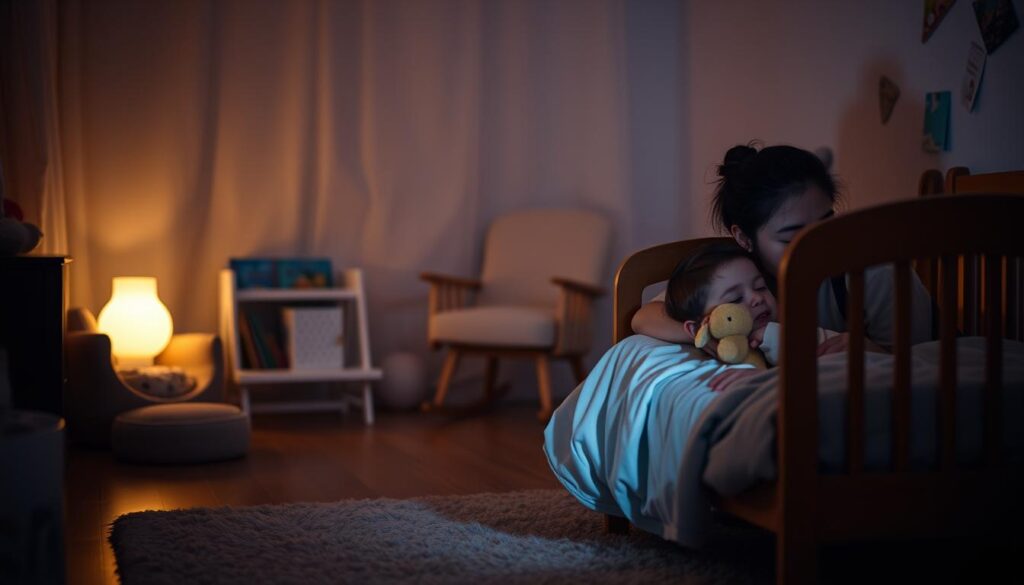Are you tired of the nightly struggle to get your toddler to sleep? As a parent, I’ve been there too, and I know how frustrating it can be.
Creating a consistent bedtime routine can be a game-changer. It’s not just about getting your child to sleep; it’s about establishing a calming pre-sleep process that benefits their overall development.
In this article, I’ll share expert tips that have helped numerous families achieve a peaceful bedtime experience. You’ll learn how to transform bedtime into a bonding opportunity and improve your child’s sleep quality.
Let’s explore how a well-crafted routine can make a difference in your child’s life and yours.
Why Toddlers Need a Consistent Bedtime Routine
A bedtime routine is more than just a series of activities; it’s a foundation for your toddler’s overall development. As a parent, you’ve likely noticed how a consistent routine can transform your child’s sleep and overall behavior. Research supports this observation, showing that bedtime routines can significantly reduce tantrums and improve sleep quality.
The Science Behind Bedtime Routines
Studies have found that a bedtime before 9:00 pm leads to better toddler sleep, and age-appropriate sleep schedules result in better behavioral outcomes. A consistent bedtime routine helps regulate your child’s internal clock, making it easier for them to fall asleep and stay asleep.
Benefits for Your Child’s Development
Beyond improving sleep, a consistent bedtime routine offers numerous developmental benefits. It helps your toddler develop self-regulation skills, improves emotional regulation, and enhances language development through quiet activities like reading. A predictable routine also provides a sense of security and control, supporting your child’s autonomy and confidence. For instance, a study showed that children with regular sleep schedules perform better on cognitive tests and have improved attention spans. By establishing a consistent routine, you’re not only improving your child’s sleep but also laying the groundwork for lifelong healthy habits. You can explore more about bedtime routines for older children on our page about bedtime routines for 10-year-olds.
Finding the Ideal Bedtime for Your Toddler
Figuring out the best bedtime for your toddler is a critical step in creating a consistent sleep routine. When kids fight bedtime, it’s often a clue that their bedtime is either too early or too late.
If bedtime is too early, your child might show no signs of fatigue and fight sleep for 30 to 60 minutes. On the other hand, if bedtime is too late, your toddler may have trouble waking in the morning and show clear signs of tiredness at bedtime.
Age-Appropriate Bedtimes
Understanding the appropriate bedtime for your toddler’s age is crucial. While the exact bedtime can vary, being aware of age-related sleep needs can guide you in setting a suitable bedtime. For more information on handling toddler sleep problems, you can visit this resource.
Signs Your Toddler’s Bedtime Needs Adjustment
Several signs indicate that your toddler’s bedtime needs adjustment. These include:
- Taking more than 30 minutes to fall asleep, suggesting bedtime might be too early.
- Falling asleep immediately but waking frequently during the night, indicating bedtime might be too late.
- Excessive crankiness, shorter naps, or falling asleep during the day, signaling a need for bedtime adjustment.
- Morning wake-up patterns, such as difficulty waking or consistently waking before 6 AM, which can indicate if bedtime is too late or too early.
Essential Toddler Bedtime Routine Tips for Success
To ensure your toddler gets a good night’s sleep, a well-planned bedtime routine is essential. As a parent, establishing a consistent and calming pre-sleep routine can make all the difference in your child’s ability to fall asleep quickly and sleep soundly.
Consistency is Key
Maintaining a consistent bedtime routine helps regulate your child’s internal clock, making it easier for them to fall asleep at the same time every night. This consistency also helps in developing healthy sleep habits.
Creating the Perfect Sleep Environment
Your toddler’s sleep environment plays a crucial role in their ability to fall asleep and stay asleep. Ensure the room is dark, quiet, and at a comfortable temperature. Consider using white noise machines or a fan to block out any background noise.
Managing Screen Time Before Bed
Avoiding screen time before bedtime is crucial for promoting healthy sleep in toddlers. The blue light emitted from screens interferes with melatonin production, making it harder for your toddler to fall asleep. Here are some tips to manage screen time effectively:
- Implement a “no screens” rule at least 1-2 hours before bedtime
- Offer calming alternatives like picture books or gentle music
- Model healthy screen habits yourself by putting away your devices during the bedtime routine
- Consider using blue light filters on necessary devices in the evening
By following these tips, you can create a bedtime routine that helps your toddler sleep better, leading to a more rested and happy child.
| Tip | Description | Benefit |
|---|---|---|
| Consistency | Stick to the same bedtime and routine every night | Regulates internal clock |
| Sleep Environment | Ensure the room is dark, quiet, and comfortable | Promotes better sleep quality |
| Screen Time Management | Avoid screens before bedtime | Improves melatonin production |
Tip #1: Start with a Gradual Wind-Down Period
Helping your toddler transition to a peaceful bedtime begins with a gradual wind-down period. This crucial step signals to your child that it’s time to sleep, making the bedtime routine smoother and more effective.
Transitioning from Active Play to Quiet Time
Transitioning from active play to quiet time is essential for your toddler’s bedtime routine. Begin by gradually reducing the intensity of activities about 30-45 minutes before bedtime. This allows your child to unwind and prepares their mind and body for sleep. For instance, you can start by switching from energetic games to more subdued activities like reading or puzzles.
Setting the Stage with Dimmed Lights and Quiet Voices
Creating the right environment is crucial for a successful bedtime routine. Start by dimming the lights throughout your home, not just in your child’s room, to signal that bedtime is approaching. Use quiet voices and minimize background noise to create a calm atmosphere. Consider playing soft, instrumental music to help your child relax. By consistently setting the stage with these cues, you’ll help your child’s brain associate these actions with sleep time.

Tip #2: Establish a Predictable Sequence of Activities
A predictable sequence of activities can make bedtime easier for your toddler. By establishing a consistent bedtime routine, you’re helping your child understand that it’s time for sleep. Research supports the effectiveness of this approach, showing that a well-structured routine can lead to faster sleep times and longer sleep duration.
For example, Philadelphia researchers found that parents who started a 3-step bedtime routine (bath, massage, and quiet cuddling or singing a baby lullaby) saw success within 2 weeks. Their children (7 to 36 months old) fell asleep faster and slept longer. You can tailor the routine to your child’s needs, choosing activities that promote relaxation and calmness.
Sample 30-Minute Bedtime Routine
A 30-minute routine can be a great starting point. Here’s a sample sequence:
| Time | Activity |
|---|---|
| 10 minutes | Bath time with gentle play |
| 5 minutes | Pajamas and teeth brushing |
| 10 minutes | Reading a book together |
| 5 minutes | Quiet cuddles and goodnight rituals |
Sample 45-Minute Bedtime Routine
A slightly longer routine can offer more opportunities for connection and calming activities. Here’s a sample 45-minute sequence:
- 10 minutes for a warm bath with gentle play
- 5 minutes for teeth brushing and pajamas
- 5 minutes for a calming lotion massage
- 15 minutes for reading stories
- 5 minutes for a quiet song or lullaby
- 5 minutes for final cuddles and goodnight rituals
For more information on creating a successful bedtime routine, you can visit Sleep Training resources or learn about bedtime stalling tactics to anticipate and prevent resistance.
Tip #3: Incorporate Calming Activities
As we explore the third tip for a tear-free toddler bedtime routine, incorporating calming activities stands out as particularly effective. Calming activities are crucial in helping your toddler relax and prepare for a restful night’s sleep. By including these activities in your bedtime routine, you can create a soothing experience that signals to your child that it’s time to wind down.
Bath Time as a Relaxation Tool
A warm bath can be a wonderful way to unwind before bed. The key is to keep the bath short and at a comfortable temperature. This relaxing experience can help your toddler’s muscles relax, making it easier for them to fall asleep. You can enhance the experience by gently speaking or singing softly.
Bedtime Stories and Their Benefits
Reading bedtime stories is not only a great way to bond with your child but also an effective way to calm their mind. Choose stories with soothing themes and gentle narratives. This quiet time together helps your toddler’s brain wind down, preparing them for a peaceful night’s sleep. As you read, use inflection and emotion to bring the story to life, making it more engaging and calming.
Gentle Massage and Physical Contact
Gentle massage is a powerful tool in your bedtime routine. It helps your toddler’s nervous system shift from “alert” to “rest” mode. Using a small amount of warm, natural lotion or oil, such as coconut oil, can add a soothing sensory element. Focus on areas that carry tension, like the shoulders, back, hands, and feet, using slow, rhythmic movements. A particularly effective technique involves gentle forehead strokes from the eyebrows up toward the hairline, encouraging heavy eyelids. This quiet, focused time together not only calms your child but also strengthens your bond.
By incorporating these calming activities into your toddler’s bedtime routine, you can create a peaceful transition from the day’s activities to a restful night’s sleep. As a parent, being part of this calming process is a special way to connect with your child, making bedtime a positive experience for both of you.
Tip #4: Use Visual Aids to Reinforce the Routine
Visual aids can be a game-changer in establishing a consistent bedtime routine for your toddler. By creating a visual chart, you can help your child understand the steps involved in the routine and make it easier for them to follow.
Creating an Effective Bedtime Routine Chart
To create an effective bedtime routine chart, involve your toddler in the process. Let them help you choose the images or illustrations that will be used on the chart. This will make them feel more invested in the routine and more likely to follow it. You can use a simple chart with pictures or illustrations that represent each step in the routine, such as bath time, brushing teeth, and reading a book.
How to Implement Your Chart Successfully
To implement your chart successfully, start by reviewing it with your toddler during a calm daytime moment. Explain each step and practice how you’ll use it before actually implementing it at bedtime. When first using the chart, offer enthusiastic praise each time your toddler completes a step. Consistency is key, so reference the chart every night in the same way, even when you’re tired or rushed.
- Make it a special event by involving your toddler in creating or choosing the images for the chart.
- Allow your toddler to move the marker or check off completed steps to give them a sense of control.
- Gently redirect their attention to the chart if they resist a particular step.
- Encourage your toddler to “read” the chart to you as they become more familiar with the routine.
By following these tips, you can create a visual aid that will help your toddler understand and follow the bedtime routine, making it easier for everyone. The simple act of following the chart gives your child a sense of control over their routine, while maintaining your loving boundaries and expectations.
Tip #5: Set Loving Boundaries Around Bedtime
Toddlers often test bedtime boundaries, making it vital to establish a consistent and loving approach. As a parent, your response to bedtime resistance sets the tone for future nights. Consistency in your reactions is just as important as consistency in the bedtime routine itself.
Anticipating and Preventing Stalling Tactics
To avoid bedtime battles, anticipate your toddler’s stalling tactics and have a plan in place. This might include using a consistent phrase like “It’s sleep time now. We’ll have time to play tomorrow” to signal that bedtime is non-negotiable.
- Maintain a calm, confident demeanor to reduce resistance.
- Avoid getting pulled into debates or negotiations.
- Use consistent phrases to redirect bedtime behavior.
Consistent Responses to Bedtime Resistance
Consistency is key when dealing with bedtime resistance. If your toddler gets out of bed, calmly and quietly return them to bed with minimal interaction. Making middle-of-the-night encounters boring helps discourage repeat performances.
| Consistent Response | Benefits |
|---|---|
| Calmly returning your toddler to bed | Discourages repeat performances |
| Using consistent phrases | Helps your toddler learn bedtime boundaries |
| Praising good bedtime behavior | Reinforces positive routines |
By setting loving boundaries and being consistent, you create a secure environment for your toddler to surrender to sleep. Remember, boundaries and love go hand-in-hand, helping your child develop healthy sleep habits.
Handling Special Circumstances and Routine Disruptions
Handling special circumstances and routine disruptions is a crucial aspect of parenting a toddler. Life is full of unexpected events, and maintaining a consistent bedtime routine can be challenging during these times. Whether it’s travel, holidays, illness, or having a babysitter or family member handle bedtime, there are strategies to help keep your toddler’s routine on track.
Travel and Holidays
During travel or holidays, try to maintain your toddler’s regular bedtime routine as much as possible. This might mean bringing familiar items like a favorite blanket or toy to provide comfort in a new environment. Be flexible, but keep the core elements of the routine consistent.
Illness and Other Disruptions
When your toddler is ill or there’s another disruption, adjust the routine accordingly. For instance, if they’re not feeling well, you might need to shorten the routine or make it more comforting. The key is to be flexible while still providing a sense of security and familiarity.
When Babysitters or Family Members Handle Bedtime
When others handle bedtime, it’s helpful to provide them with a written or visual guide to your bedtime routine. Prepare your toddler in advance by explaining who will be putting them to bed. Creating a simple “cheat sheet” for caregivers with specific details can help maintain consistency. For regular caregivers, allow them to add a special element to the routine while keeping the core structure intact.
By being prepared and flexible, you can help your toddler navigate special circumstances and maintain a sense of security and routine.
Troubleshooting Common Toddler Bedtime Challenges
Bedtime can be challenging for toddlers, and it’s not uncommon for them to fight sleep or develop nighttime fears. As a parent, it’s essential to address these issues with empathy and understanding.
When Your Toddler Fights Sleep
When your toddler resists sleep, it can be due to various factors, including an inconsistent bedtime routine or an environment that’s not conducive to sleep. Ensuring the room is dark, quiet, and at a comfortable temperature can help. Establishing a calming pre-sleep routine can also signal to your child that it’s time for bedtime.
Dealing with Nighttime Fears
Nighttime fears are a normal developmental phase for many toddlers. To comfort your child, consider using a nightlight or leaving a family photo near their bed. You can also create a “monster spray” or a “protection charm” to give your toddler a sense of control. Validating their feelings with reassurance, such as “I understand you’re feeling scared,” can be comforting. Teaching your child to repeat self-soothing phrases like “I am safe in my bed” or “My family is nearby” can also help.

Conclusion: Creating a Peaceful End to Each Day
As we wrap up our journey through creating a serene bedtime routine for your toddler, it’s clear that the benefits extend far beyond a good night’s sleep. By establishing a consistent and calming routine, you’re not only helping your toddler sleep better but also fostering healthy habits that will last a lifetime.
For more insights on finding the ideal bedtime for your child, explore our resources to create a peaceful bedtime experience. With patience and persistence, bedtime can become a beautiful connection point between you and your toddler, making it a cherished moment in your daily routine.
FAQ
How long should a child’s nightly bedtime routine be?
A consistent bedtime routine should last around 30 to 45 minutes, giving your child enough time to wind down and prepare for sleep.
What are some calming activities to include in a young child’s bedtime routine?
Calming activities like a warm bath, reading a book, or gentle massage can help signal to your child that it’s time for sleep.
How can I make sleep time more predictable for my child?
Establishing a consistent bedtime and a predictable sequence of activities can help your child feel more secure and in control.
What should I do if my child resists going to bed?
Anticipating and preventing stalling tactics, and responding consistently to bedtime resistance, can help your child learn to cooperate with the bedtime routine.
How can I handle disruptions to our nightly bedtime routine, such as during travel or illness?
Being flexible and adjusting the routine as needed can help minimize disruptions. For example, you can try to maintain some elements of the routine, even on holidays or when traveling.
Can a visual chart help with our child’s bedtime routine?
Yes, creating a bedtime routine chart can help your child understand the sequence of activities and feel more in control.
How can I make bath time a positive experience for my child?
Using warm water, gentle products, and making it a relaxing experience can help your child look forward to bath time as part of the bedtime routine.
What are some ways to create a sleep-conducive environment for my child?
Dimming the lights, reducing noise, and maintaining a comfortable temperature can help create a sleep-friendly environment that promotes healthy sleep habits.




